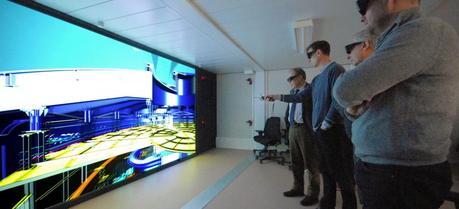 The visualization software enables the design engineers to literally "walk through" the ITER machine and the surrounding Tokamak Complex. (Credit: ITER)
The visualization software enables the design engineers to literally "walk through" the ITER machine and the surrounding Tokamak Complex. (Credit: ITER)
After two years of relying on technology installed at the neighboring CEA Institute for Magnetic Fusion Research (IRFM), the ITER Organization last week celebrated the official inauguration of its own virtual reality room.
The technology was installed at the end of last year in a small annex at the back of the former Headquarters building. Once the new extension to ITER Headquarters is finalized, the equipment will be moved to its permanent location in a dedicated area for virtual reality.
The visualization software, Techviz, enables the design engineers to literally “walk through” the ITER machine and the surrounding Tokamak Complex. The 2.5 × 4 m screen makes cooling water piping, vessel supports and any other plant system or component appear true-to-size. “This is certainly impressive to see and, admittedly, also fun,” says Jens Reich, who is managing the design integration of the Tokamak.
“A 3D tool like this is essential from the design integration point of view. It allows us to check the design of mechanical and plant systems or certain construction features. And it allows us to discuss interfaces in front of the big screen directly with the representatives of the different areas. Remote participation of our colleagues in the Domestic Agencies, during review meetings for example, is also foreseen.”
And there is another nice feature of this technology: with the help of a special set of target points it is possible to immerse people—virtually—into the corridors and utility shafts, allowing accessibility studies in certain restricted areas.
The annex building containing such sophisticated virtual reality technology is connected to the Enovia design software which allows the loading of the 3D data directly from the ITER CAD database. Several members from within the Design Integration team are currently undergoing special training in order to operate the virtual reality technology and to answer to the increasingly frequent requests for the use of this new tool.

